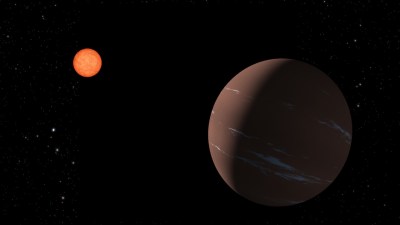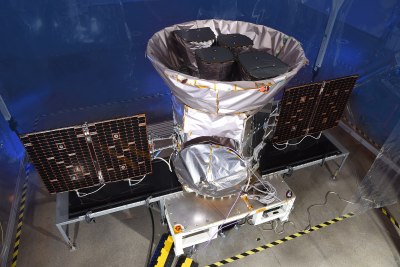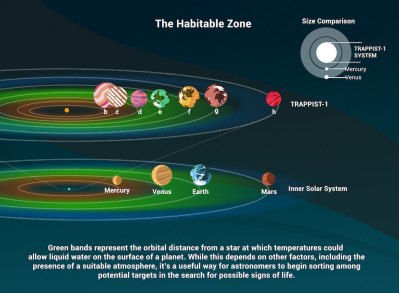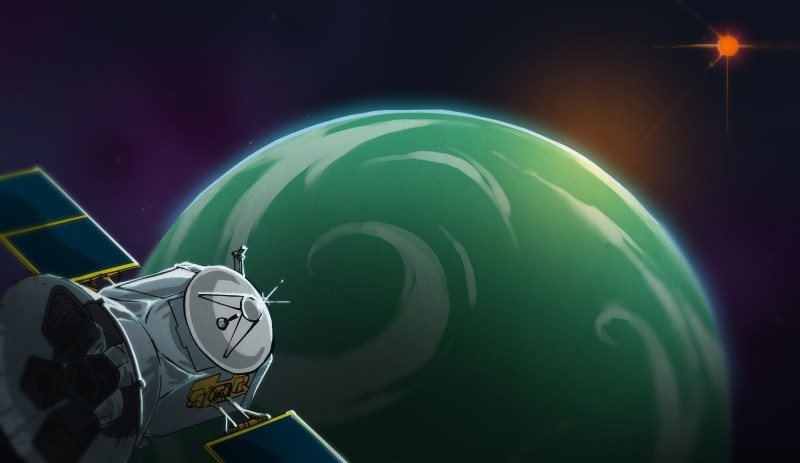Earth is a rather special place, quite unlike the other planets in the solar system. It’s nestled at the perfect distance from the sun to allow our water to remain liquid and for life to flourish in turn. It’s a rare thing; most planets are either too close and scorching hot, or too far and freezing cold.
NASA is always on the hunt for planets like our own, and recently found a new super-Earth by the name of TOI-715b. The planet is larger than our own, but it’s position and makeup mean that it’s a prime candidate for further study. Let’s take a look at how NASA discovered this planet, and why it’s special.
On The Hunt

The search for Earth-like planets is inherently a key part of the search for other life in the universe. After all, at this time, the only place we know of that hosts life is our own planet. Thus, if we’re looking for more life, we’d expect to find it somewhere similar. Thus, NASA has put plenty of effort into finding these Earth-like planets, along with Super-Earths, that are like our own, only larger.
This hunt is handled by the Transiting Exoplanet Survey Satellite, or TESS for short. As you might guess from the name, it’s a satellite charged with the specific job of finding far-off planets. It achieves this by watching distant stars for the characteristic shadow of an orbiting planet passing in front of them; these are referred to as “transits.” TESS was charged with examining bright stars near to our Sun in order to hunt for these transit events which give away the location of potential planets.

Originally designed for a two-year mission, having entered service in 2018, TESS continues its work today to identify new planet candidates in other solar systems. By November 2023, it had identified a total of 6,977 candidates, with 402 of those being confirmed as actual planets. Unlike other telescopes, which have mostly identified very distant or very large planets, TESS’s telescopes have proved capable of detecting much smaller planets closer in size to our own Earth.
In the case of this new discovery, known as TOI-715 b, NASA has turned up quite the exciting find. The planet exists within what is termed the “conservative” habitable zone around the star which it orbits. This is a region in which a planet could conceivably orbit and host liquid water. It’s not a guarantee, as such a planet would also need to have the right atmosphere, but it opens up the possibility. This “conservative” zone is much narrower than the “optimistic” habitable zone, where a planet could have liquid water with a lower degree of certainty.
TOI-715b is also quite close to Earth in size, being roughly 1.5 times the diameter of our planet. It orbits a red dwarf star, which is somewhat smaller than our yellow dwarf Sun. The star is also cooler than the Sun, which allows a planet to orbit closer without overheating beyond the point where liquid water could exist on the surface. Stars like these have proven compelling targets for scientists hunting potentially-habitable planets; one such solar system known as TRAPPIST-1 has already been found to have a gaggle of small planets in its habitable zone. As for TOI-715b, its close orbit gives it a year just 19 days long.

TESS has also discovered a potential other planet of interest in the same system. If confirmed, this slightly-smaller planet, closer to Earth’s size, could be the smallest habitable-zone planet yet identified by NASA.
For now, there is still much work to do. Scientists hope to identify whether TOI-715b really is a “water world” or not, and work to achieve that could be carried out with the Webb telescope. Ideally, the planet will have an easily-detectable atmosphere to keep it in the right temperature range to allow liquid water to exist on its surface.
As our understanding of the universe continues to evolve, we’re learning more about what’s out there every day. What we find is often new and unusual. But when we’re looking for other habitable planets, we’re often looking for something familiar, just like home! This Super-Earth, or another out there, could turn out to be just that.

















An orbit of only 19 days? That has to be tidally locked! I hope a tidally locked planet can be habitable, given how many keep being found but I am skeptical. Then there is the question of flares so close to the star.
Yeah, exoplanet/astrobiology types love to try to find ways to pull a Monty Python and claim that these planets are just pining for the fjords, but… yeah, there’s probably a reason that we orbit a G-type star.
GREAT book although the title should have included “probably” instead of being so definitive:
Rare Earth: Why Complex Life is Uncommon in the Universe
Yeah, but think: no need for a freezer for the beer of grill for stake. You just open the propely insulated door from the sunny side or the one from the night side. All you need is a house in the perpetual dawn ring.
And build it like a friggin bunker, because the weather in such a situation is going to be extremely frightening.
And the radiation. Does a tidally locked planet ever have a significant magnetic field? The core might be molten and moving still, who knows. But it’s doubtful it would be of much help that close to the star.
“Does a tidally locked planet ever have a significant magnetic field?”
Oh, sure. It’s still rotating, it just happens to be that its rotation matches the orbital period. Its sidereal rotation period is still 19 days, so “all else being equal”, since the magnetic field is proportional to square root of the frequency, it’d only be sqrt(19) (~4.4) times weaker.
The charged particle flux, however, would be ludicrously higher, so as you point out it wouldn’t help much.
If Mars is suppose to be viable then you might as well call that viable too eh.
The boundary would be VERY interesting.
Researcher should instead focus on planets which orbit G and K stars and forget about those of M stars (radiation and tidally locked)
There are way more lone M stars closer to Earth than F/G/K.
It just takes longer to detect planets via transits in the habitable zone near F/G/K stars. If it takes a year for the planet to transit and you need multiple transits, you’re waiting multiple years, period.
Looking for planets around M stars doesn’t prevent you from looking for F/G/K. They happen at the same time. You just get more M star discoveries (because there are more) and they come faster (because they’re easier).
How bout all scientist stop theorizing and and put there big heads together to prove any of this, put a gas station on the moon and send these idiots that know it’s a one way trip to planets in our own system to physically research and send info back.
You first! I bet those “Big-headed idiots” know all sorts things you do not, like the difference between “there” and “their”.
Prove?? Prove?? There is no money in proving anything with Galactic theories!! You’ll just have to believe me that these planets exist… now give me your money and step aside!!
It’s mainly the M ones we have the technology to spot just now.
Just an amateur astronomer but it seems majority of planets orbiting near red dwarf has poor chance of life form developing. The close proximity of the star and being tidally locked often mean the sunny side is also blasted with lots of radiation. If we find life there, it may be in deep water, in caves, in shadow of the mountains, and downwind side of the planet past the horizon with limited radiation from the star.
Excess radiation would prevent amino acid from forming and allowing life to develop. If we build habitation on such planets, it’d have to be shielded from the star and you wouldn’t be able to go outside for suntanning. You’d get cooked like in microwave.
I’m still thinking we’d have better chance at finding safe habitable planets that are further away which would mean not around red stars. Orange/yellow/white mainstream are likely safe bet for us and has high chance of complex lifeform developing as well. Giants and super giant classes are unlikely to have any due to often short and unstable life of the star
My instincts agree, although the astrobiology types actually argue that UV is necessary for organic molecule production and so the flares actually might be *necessary* to kickstart things on M-dwarfs.
There’s a paper from a number of years ago (“The origin of RNA precursors on exoplanets”) which has a neat diagram which overlays the habitable zone and what they call the “abiogenesis zone” where the star has enough UV to make pyrimidine: both Earth and Kepler-452b land squarely in the middle of both.
What is the point of this? Traveling to these planets is virtually impossible. It’s a know fact traveling at the speed of light is impossible for large mass objects like space ships. Even if we set out on a journey you die of old age before you get there. If you traveled there and it’s uninhabitable then what. You sent your children’s children to a dead end.
No NASA scientists just want to study it and find out more on how our own planet formed life. Also I heard recently that our planet has already used up 80% of needs of life and only have 20% left until it dries up.
Please advise where you read that.
I read about this in a different article where they said that this planet is like 330 light years away, this article left that part out. And for anyone you doesn’t understand what a light year is listen up.. la light year is the distance light travels in one year and that happens to be approximately 6trillion miles. So multiple 6 trillion by 330 and that is how many miles away this planet is and if we could travel the speed of light it would still take us 330 years to get there. I really don’t understand and would love to hear from the geniuses that spent millions and millions of dollars to study planets we will never get to.. All the wasted money and resources that the is wasted on this crap is criminal.
Yes, what’s the point of “science” or “understanding” or “learning?” Useless, the lot of them. Everyone should either work sixteen hours a day or be in prison.
Aint nobody ever going nowhere 💯 so just forget about it and watch some more sci-fi movies
Columbo, Wright Brothers, and Gagarin entered the chat.
How about the fact that
The preprint’s here: https://arxiv.org/abs/2305.06206
Hilariously, the preprint has *less typos* than the actual MNRAS paper. For some weird reason all of the instances of “instellation” (which is the generic form of ‘insolation’) got changed to ‘installation’ because some editor or spellchecking software is stupid.
And yes, it’s a red dwarf planet, so yes it’s probably tidally locked and being battered by flares, which of course leads to the phrase “one could carefully speculate” and “there might be a chance [astrobiology] could still exist,” and hopefully you can read into those weasel-words correctly.
From a science point of view (as opposed to the “we want aliens!” point of view) the interesting thing is that “super earths” between 1.5-2x Earth’s radius are weirdly rare – this gets called the “radius valley” and leads to a weird distribution of planet radii (with peaks at 1.5 and 2.5). This planet falls basically right on the edge of that, so planets like this can be helpful for understanding whether this is real and what causes it.
*fewer typos :)
I remembered a twilight zone episode where a man was sent through a door to another dimension to check what was in the other side and he should come back to inform, so he discovered the previous guys that were sent having a time of their lives in a paradise. If you were to sent to TOI-715b and you find a peaceful civilization in a paradise planet, would you inform back? Or you would be more like: you must prepare for war! they are coming! This dilemma was explored in Star Trek also I think. Or maybe just like nah! I’m not going back… It sounds like scifi I know but someday it won’t.
Like in the movie Stargate, Kurt Russell refuses to leave the far away planet they found.
I forget exactly why.
He didn’t refuse to leave, he couldn’t leave because no one knew the correct “phone number” to dial back to Earth. Eventually Daniel finds the old stone slab with the number to return to Earth, and the surviving group minus Danial finally returned to Earth after blowing up Ra.
A year later SG-1 series resumes where the movie left off.
It was James Spader who refused to leave, because he got married due to accepting a ritual gift. Kurt Russell armed the nuke.
It’s a forgettable movie with a simplistic plot. the tv series was way better.
I disagree. The movie was not forgettable. You and I remembered it both.
LOL
Wasn’t it that Kurt Russell’s son died and so he was depressed. He was there to try and blow the portal up if there were ‘bad guys’ on the other side that tried to come through to Earth.
This Star Trek assumption that the default being is incredibly gentle and pacifist and that humans are the foolish “war species” is only possible with the most modern bourgeois morality. We think we are warlike because we are so far removed from violence. This is an unusually peaceful era of history, and it’s not likely to last very long. People will eventually come to miss Pax Americana and our quaint proxy wars.
“This Star Trek assumption that the default being is incredibly gentle”
What version of Star Trek are *you* watching???
If I must to be honest to myself I guess I would warn the discovered civilization about the imminent coming storm, our human history has many records of what happens when two civilization crash. Of course human nature is always the same no matter the place, race or period of time and we cannot say anything about a nonhuman civilization if such a thing exists. Are we so far removed from violence?. mhm…What do you think guys?
In the other hand, what if they just vaporize our planet with a single click from the planet killer? damn I need more coffee.
Klingon didn’t exactly welcome Human with open arms. Andorian were rather rough and constantly butted head with the Vulcans, who themselves were a bit more militaristic spying on Andorian. Romulans offered nothing but cold shoulder until their home world got destroyed. Cardassians, Breens, and Tholian didn’t offer welcomes either.
Even in one TNG episode where Riker nearly died, the race that was about to discover warp drive, some of the people were fearful of aliens and in the end the race and Starfleet decided to just part way and let the race take its time before going back into space.
See, your plot could describe any number of episodes, but I would still guess on TNG S4E15 First Contact.
Even if that were true and I did find a planet it was like paradise I would still want to come back to my own planet Earth it’s like going on a vacation to a fantastic place but no matter how great it is you always can’t wait to come home I don’t know if that makes any sense.
I can imaging the first probe and rover launched to one of these “erath 2” planets, and if they are occupied already with sufficient technology to understand, the effect it would have on their planets population. And then I flip the direction and imagine an alien probe and rover sent to earth and the effect it would have, if we have sufficient technology to notice the probe (could be stealth), on earths population. The odds are that possession of such a probe would kick off a world war if access to every nation was not given freely.
Well with that attitude why waste money on many things?
Good point. 100% agree. We should cut more than just the NASA budget. We should cut most other military spending as well.
Red Dwarfs are a no-good, plain and simple.
Why not both? It’s not like the U.S. isn’t the richest country in recorded history.
Another good point. Why not both? Are we funding feeding starving children? I’m not aware of any government program that has NASA’s funding that does any kind of domestic humanitarian work.
NASA budget was like $25B. Social security was $1.4T, health insurance $1.5T. You bing “unaware of…” is massively misinformed.
“I’m not aware of any government program that has NASA’s funding that does any kind of domestic humanitarian work.”
NASA does, in fact, do humanitarian work? Earth-sensing observatories can be used for any number of humanitarian reasons.
These things are not mutually exclusive. We can afford to fund both. We can afford to fund a lot of programs. However, the practical application of such programs is not really that great. We know enough about how our economic mechanisms work to employ a few nudges here and there so that such programs should deflate in budget due to not being needed as much. There’s no social safety net for housing. housing is still for profit. There are some very poor social safety nets for food, but they are very difficult to get, and take time to apply for and not everyone that needs them, gets them. I think overall, there are bad actors, and also people that act in good faith, but have no idea what the hell they are doing. The quality of such programs is poor and so many in need that it’s not even a band aid on a gaping wound. Having said that, you can decide that any one budget spending item (or a dozen of them) are “useless”. But in the grand scheme of things, most of our programs were created in order to solve a problem. They are now entrenched, and are massive machines that are difficult to change. Partially because people are afraid of change, and partially because there is lots of work involved. The other reason being politicians griping about ‘spending money’. Realistically speaking, our local infrastructure should take care of itself. federal programs are, due to their nature, incapable of achieving the actual social results that we strive for. ie: i know that when i’m in need, there isn’t a single program out there that really helps out in any way, shape or form, it’s always people i know personally. having said that, i’d rather pay for nasa than have billionaire freeloaders get money to fly p***is shaped rockets to (not) space. I’d also rather give 5 bucks to the people in need in my community rather than “rounding up” at some stupid checkout line. That five bucks goes a long way in my community, for that person. The “round up” at the check-out line is another tax bailout for x corporation and lines the pockets of “administrators” of the “non profit”. If you want change, affect it. Pointing at “big spending” on whatever other project, is not an effective way to foster change and lift up the lives of those around you.
it should be effect it
SUPER EARTH. Our home…
Hey are they all flat? 🤔🤣
🤣🤣🤣
Information I read recently suggests that planets around red dwarfs eventually have their atmospheres stripped away, whether they are in the habitable zone or not.
So being on a tidally locked planet without an atmosphere around a star throwing out all sorts of unhealthy radiation seems to be problematical. Although never say never, red dwarfs might need to be crossed off the list for future holiday destinations.
Let’s all take a trip back in time when we had 9 planets including Pluto and the possibility of life here was much greater, now we have more exoplanets with less possibilities but we still have to achieve warp capability to reach any one of them. A long road to nowhere and a bleak future for our civilization awaits while life could’ve existed elsewhere many, many light years ago. The stars their self maybe in their dying stages.
“but we still have to achieve warp capability”
Why in the world do people cling to this bizarre idea? I get that a large part of it is the sci-fi obsession with it, but… let me make the problem clear.
The problem with getting to other planets right now is that it takes too long, compared to how long we live, to get there. So we can either:
1. break the laws of physics
2. break the laws of biology
If your response is “wait, ‘laws of biology’? what laws of biology?” you’ve probably figured out which of the two is possible.
Why are they talking about liquid water where it’s clear that such state can’t exist on a tidally locked planet ?
For liquid water to harbor life, it requires a water cycle and plenty of it. In a planet whose face is locked to the star, the temperature will ALWAYS be larger than the boiling limit and the dark size will always be frozen. Thus on the terminator, even if liquid water could exist, it can’t go from anywhere to anywhere. Water can’t move far enough to transport chemicals required for life. And so on.
“where it’s clear that such state can’t exist on a tidally locked planet ?”
Not that I believe it likely makes a difference, but the whole “tidally locked” thing isn’t as easy as people make it out to be, because planets aren’t homogenous bodies. Tidal forces on the atmosphere aren’t the same as the hydrosphere or the solid portion of the planet or an inner molten core.
Tidally locked planets aren’t as stable in that configuration as you might expect – most studies have found that planets in those systems tend to librate (wiggle back and forth) and then just spontaneously kick out of the locked state and rotate for a good fraction of a GYr before settling back into another configuration.
I mean, Earth itself is actually an example of that because we *should* be significantly more tidally locked with the Moon than we are, but we passed through an atmospheric tide resonance which stabilized the day length for a GYr. So, who knows.